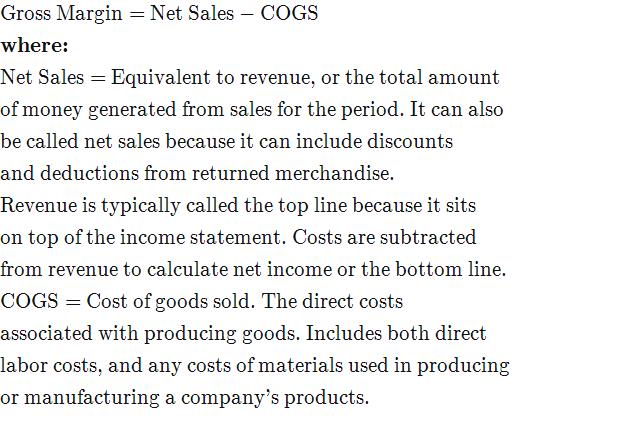Definitie van de brutomarge
Wat is de brutomarge?
De brutomarge is de netto-omzet van een bedrijf minus de kosten van verkochte goederen (COGS). Met andere woorden, het zijn de verkoopopbrengsten die een bedrijf overhoudt nadat het de directe kosten heeft gemaakt die verband houden met het produceren van de goederen die het verkoopt en de diensten die het levert. Hoe hoger de brutomarge, hoe meer kapitaal een bedrijf vasthoudt op elke dollar aan verkopen, dat het vervolgens kan gebruiken om andere kosten te betalen of om aan schuldverplichtingen te voldoen. Het nettoverkoopcijfer is eenvoudigweg de bruto-inkomsten, verminderd met de opbrengsten, vergoedingen en kortingen.
De formule voor de brutomarge is

How to Calculate Gross Margin
To illustrate an example of a gross margin calculation, imagine that a business collects $200,000 in sales revenue. Let us assume that the cost of goods consists of the $20,000 it spends on manufacturing supplies, plus the $80,000 it pays in labor costs. Therefore, after subtracting its COGS, the company boasts $100,000 gross margin.
What Does the Gross Margin Tell You?
The gross margin represents the portion of each dollar of revenue that the company retains as gross profit. For example, if a company’s recent quarterly gross margin is 35%, that means it retains $0.35 from each dollar of revenue generated. Because COGS have already been taken into account, those remaining funds may consequently be channeled toward paying debts, general and administrative expenses, interest fees, and dividend distributions to shareholders.
Companies use gross margin to measure how their production costs relate to their revenues. For example, if a company’s gross margin is falling, it may strive to slash labor costs or source cheaper suppliers of materials. Alternatively, it may decide to increase prices, as a revenue increasing measure. Gross profit margins can also be used to measure company efficiency or to compare two companies of different market capitalizations.
Key Takeaways
- Gross margin equates to net sales minus the cost of goods sold.
- The gross profit margin shows the amount of profit made before deducting selling, general, and administrative costs.
- Gross margin can also be shown as gross profit as a percent of net sales.
The Difference Between Gross Margin and Net Margin
While gross margin focuses solely on the relationship between revenue and COGS, the net profit margin takes all of a business’s expenses into account. When calculating net profit margins, businesses subtract their COGS, as well as ancillary expenses such as product distribution, sales rep wages, miscellaneous operating expenses, and taxes.
Gross margin–also called “gross profit margin”, helps a company assess the profitability of its manufacturing activities, while net profit margin helps the company assess its overall profitability.
For related insight, read more about corporate profit margins.